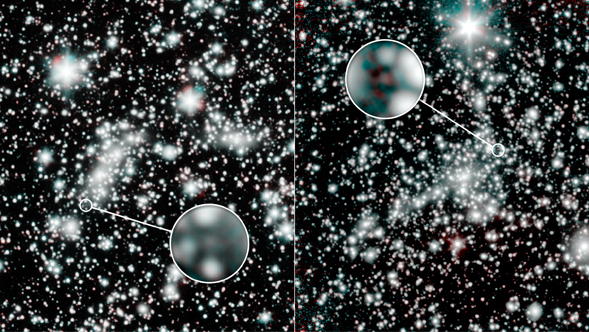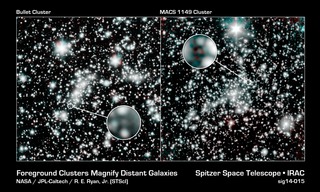
News Release • June 12th, 2014 • feature14-13 •
Through a project dubbed SURFS UP, NASA's Spitzer Space Telescope and Hubble Space Telescope are catching sight of a "wave" of galaxies that emerged in the early universe. Starlight from these primordial galaxies is reckoned to have cleared a fog of hydrogen gas that shrouded the cosmos during a mysterious period known as the Dark Ages.
Spitzer has revealed that the stars shining in two of the young SURFS UP galaxies, discovered by Hubble, look surprisingly mature. The finding suggests these stars formed earlier than expected, and thus began lifting the cosmic fog sooner than previously thought.
"We have discovered galaxies that are among the most distant ever spotted, having formed a mere 500 million years after the Big Bang," said Maruša Bradač, a physicist at the University of California, Davis and lead author of one of two papers describing the findings. "The stars within these relatively young galaxies already appear mature, pushing back the time when the first stars and galaxies arose and began illuminating the Dark Ages."
Spitzer teamed up with Hubble to gather the results as part of the Spitzer UltRaFaint Survey, or SURFS UP. The joint project will image 10 massive, foreground galaxy clusters, whose strong gravity magnifies the light of background objects. This so-called cosmic lensing causes objects such as the distant, dim, young galaxies that SURFS UP is investigating, to appear more than 10 times brighter than they normally would, allowing the team to study the stars within them.
The Spitzer observations, in infrared, reveal key characteristics, such as mass and ages, about older populations of stars in the far-off galaxies. Besides finding the galaxies in the first place, Hubble's observations, in visible light, speak to the formation rate of young stars. Taken together, the data paint a richly detailed portrait of galactic evolution and its effect on the wider cosmos.
SURFS UP is one of several new observing programs taking advantage of cosmic lensing to probe deeper into the universe than ever before. The project will complement Frontier Fields, another such program using Spitzer and Hubble data, by looking at eight additional clusters not covered by Frontier Fields. Overall, SURFS UP will look for traces of cosmically lensed background galaxies representing typical, "normal" galaxies from just several hundred millions years after the Big Bang.
The universe was a very different place at the time the first stars and galaxies began lighting up an otherwise dark cosmos. Neutral hydrogen gas, which is a very good absorber of ultraviolet light, still filled the cosmos like a fog, making the universe partially opaque to that part of the spectrum. Rather like how the warmth of the sun "burns away" fog, the first stars and galaxies likely ionized, or knocked an electron loose from, the neutral hydrogen. This ionization prevented the hydrogen from absorbing ultraviolet light, clearing the "fog." In this way, the rise of stars and galaxies that brought the Dark Ages to a close also rendered the universe transparent to some of these objects' light.
To understand definitively how and when this process occurred, scientists need an accurate picture of star formation rates and history. In a paper accepted for publication in the Astrophysical Journal, Brada? and colleagues used Spitzer and Hubble to measure the properties of stars in a 13.2 billion-light-year-distant galaxy, made possible thanks to the cosmic zoom lens provided by the galaxy cluster MACS J1149.5+2223. The overall reddish hue of starlight visible to Spitzer in the distant galaxy indicates the presence of an older population of stars than was expected in this relatively young galaxy.
A second paper generated by the SURFS UP team involves the magnification of a galaxy by the massive Bullet Cluster of galaxies. The paper, in The Astrophysical Journal Letters, describes an extremely distant galaxy, 12.9 billion light years away, which is so faint that Spitzer could only detect it using the extra boost of a foreground gravitational lens. Careful analysis of the stellar properties of this galaxy suggests it also harbors stars of an already reasonably advanced age.
"These are among the first direct detections of mature stars in young galaxies seen at the time when the universe was only a few percent of its present age," said lead author Russell Ryan, a postdoctoral fellow at the Space Telescope Science Institute. "When SURFS UP completes, we will have a census of stars in early galaxies that will help us determine what exactly ended the Dark Ages."
NASA's Jet Propulsion Laboratory, Pasadena, Calif., manages the Spitzer Space Telescope mission for NASA's Science Mission Directorate, Washington. Science operations are conducted at the Spitzer Science Center at the California Institute of Technology in Pasadena. Spacecraft operations are based at Lockheed Martin Space Systems Company, Littleton, Colo. Data are archived at the Infrared Science Archive housed at the Infrared Processing and Analysis Center at Caltech. Caltech manages JPL for NASA.





